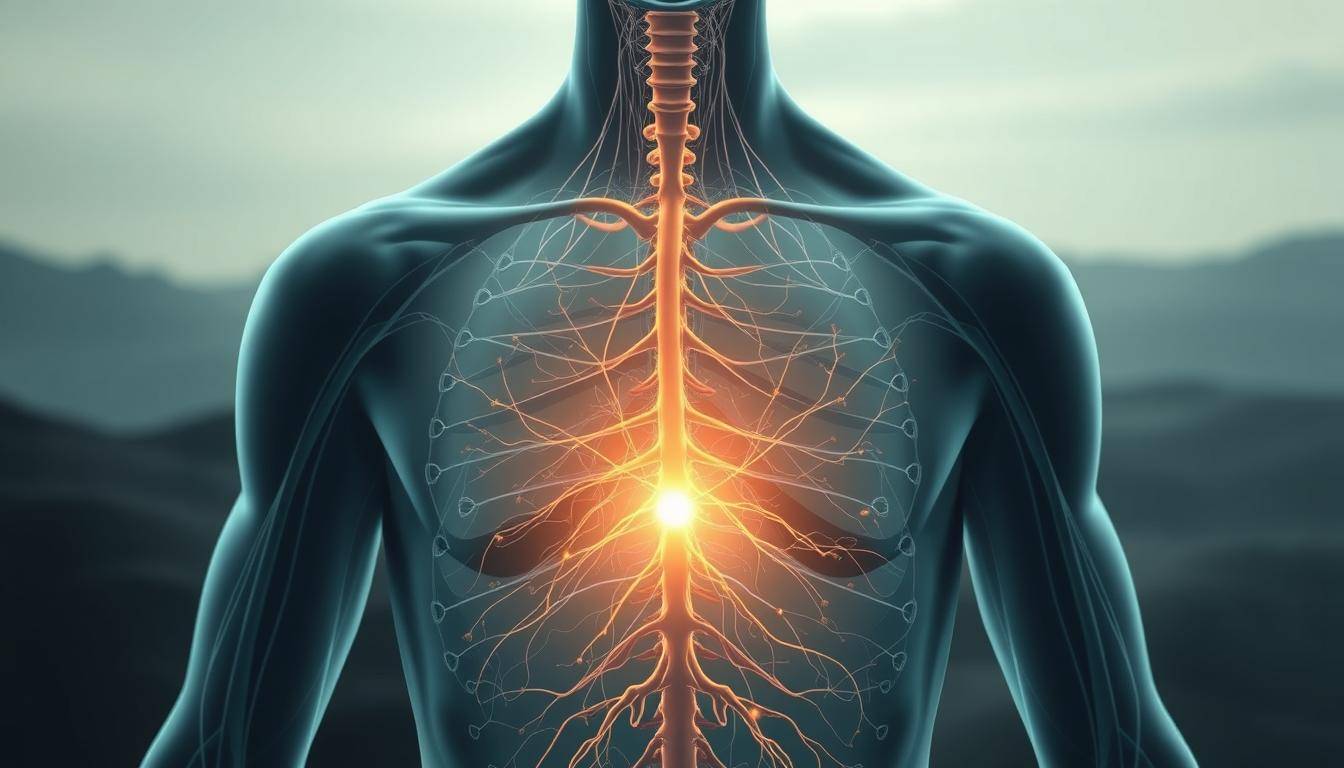“The greatest discovery of any generation is that human beings can alter their lives by altering their attitudes.” — William James. This timeless insight captures the essence of merging physiological science with intentional growth—a concept central to understanding how our biological wiring shapes our ability to create meaningful change.
At the core of this approach lies a critical component: the vagus nerve. Often called the body’s communication superhighway, it directly influences how we respond to stress, connect with others, and access states of calm. When balanced, this system becomes a foundation for resilience—and a gateway to aligning inner stability with outward goals.
Modern research reveals that our capacity to manifest desired outcomes isn’t just about mindset. It’s deeply tied to physiological patterns. By learning to regulate automatic responses, individuals gain tools to shift from survival mode to a state where creativity and clarity thrive. This article explores actionable strategies to harness these principles—combining neuroscience with practical steps for growth.
Key Takeaways
- The vagus nerve acts as a bridge between physical responses and emotional well-being
- Balancing the nervous system creates a foundation for intentional goal-setting
- Science-based techniques can enhance both personal and professional growth
- Stress management directly impacts one’s ability to pursue aspirations
- Practical tools exist to align biological rhythms with desired outcomes
Setting the Stage: An Introduction to Polyvagal Theory and Manifestation
Your body constantly scans environments for signals—a biological process shaping how you interact with challenges and opportunities. This hidden dialogue between physiology and perception forms the basis of strategies that empower lasting change.
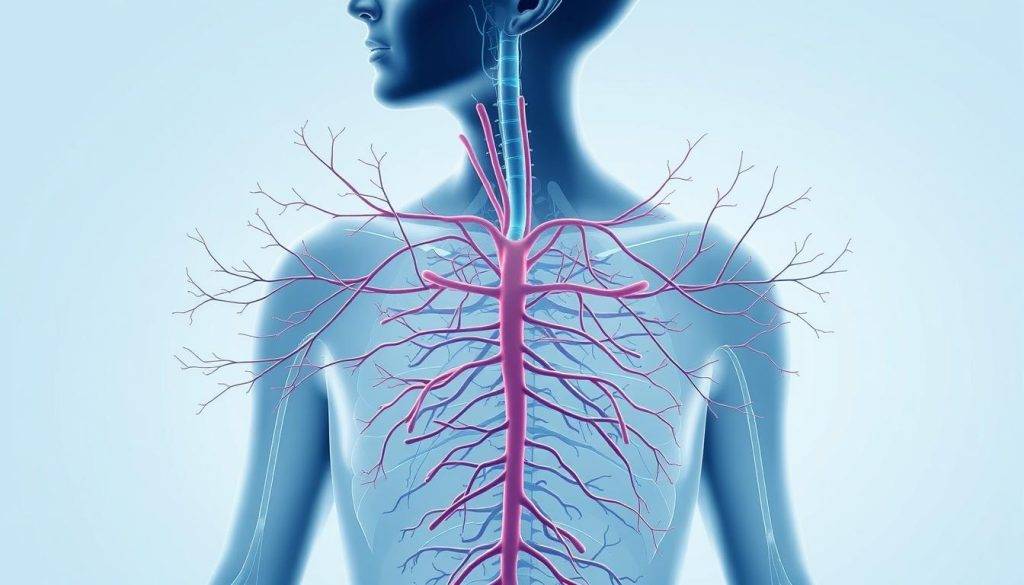
Overview of Key Concepts
The autonomic nervous system operates like a sophisticated alarm system. It manages automatic responses to stress, relationships, and relaxation. Dr. Stephen Porges, a leading neuroscientist, identified how cues of safety or danger trigger distinct biological states:
- Calm social engagement through facial expressions and vocal tone
- Fight-or-flight reactions during perceived threats
- Shutdown responses in overwhelming situations
Connection to Personal Transformation
Recognizing these patterns helps reframe mental health struggles. When your nervous system detects safety, creative problem-solving and emotional resilience flourish. Simple practices like mindful breathing or positive social interactions activate this state.
Dr. Porges’ research reveals that conscious awareness of bodily signals allows intentional shifts. By cultivating environments rich in safety cues, you create conditions where personal growth becomes sustainable—not just another self-help chore.
Understanding the Foundations of Polyvagal Theory
Neuroscience breakthroughs often reshape how we view human behavior—a truth exemplified by the work of Dr. Stephen Porges. His research challenged traditional views of the autonomic nervous system, revealing how neural pathways shape our capacity for connection and growth.
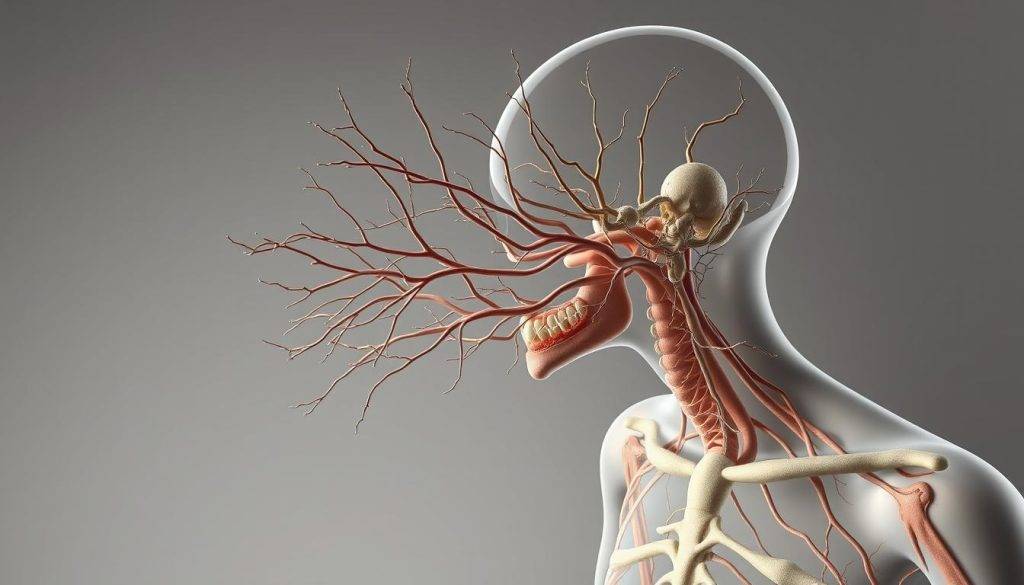
History and Development by Dr. Stephen Porges
In the 1990s, Stephen Porges identified patterns in how humans process safety and danger. His studies showed the vagal complex doesn’t just control heart rate—it acts as a social engagement filter. This discovery explained why trauma survivors often struggle with trust, as their physiological responses prioritize survival over connection.
Core Principles and Scientific Roots
Three key ideas anchor this framework:
- The body assesses safety through subconscious cues (neuroception)
- Social behaviors depend on ventral vagal activation
- Chronic stress can trap individuals in defensive states
Modern brain imaging confirms these principles. For example, when facing perceived threats, blood flow shifts from creative centers to survival regions—a process explaining why anxiety hinders clear thinking. By recognizing these biological patterns, individuals gain power to reshape their responses.
Everyday experiences mirror these concepts. Consider how a warm conversation lowers your shoulders, or sudden stress tightens your chest. These moments reveal the autonomic nervous system at work—bridging ancient survival mechanisms with modern emotional needs.
The Autonomic Nervous System and Its Branches
Behind every heartbeat and breath lies an intricate control network—the autonomic nervous system. This biological framework operates silently, managing essential functions without conscious effort. Its three branches work in harmony to protect and restore balance, shaping how we experience daily challenges.
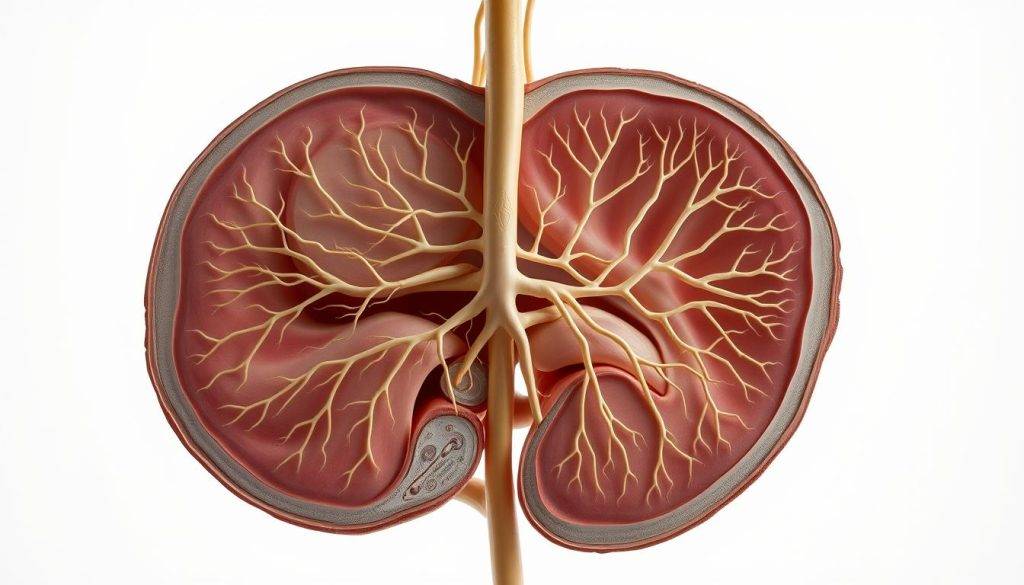
Sympathetic and Parasympathetic Divisions
The sympathetic nervous system acts as your body’s emergency responder. When danger appears, this division springs into action—increasing heart rate, sharpening focus, and preparing muscles for movement. This “fight or flight” response evolved to handle immediate threats, from predators to tight deadlines.
In contrast, the parasympathetic nervous system serves as a reset button. It slows your pulse, stimulates digestion, and promotes recovery. Think of it as the biological foundation for “rest and repair”—a state where healing and creativity thrive.
The Role of the Enteric Nervous System
Often called the “second brain,” the enteric branch governs gut function. With over 100 million neurons lining your digestive tract, it independently manages nutrient absorption and gut motility. Research shows this system communicates bidirectionally with the brain, influencing mood and decision-making.
Together, these branches create a dynamic equilibrium. While the sympathetic division prioritizes survival, the parasympathetic and enteric responses foster long-term well-being. Understanding this interplay helps explain why stress disrupts digestion—and how calm environments enhance mental clarity.
The Vagus Nerve: Anatomy and Physiological Impact
Stretching from brainstem to abdomen, the vagus nerve serves as your body’s master regulator. This cranial nerve—the longest in the human system—wanders through key organs like the heart, lungs, and digestive tract. Its dual role as sensor and commander makes it essential for maintaining equilibrium.
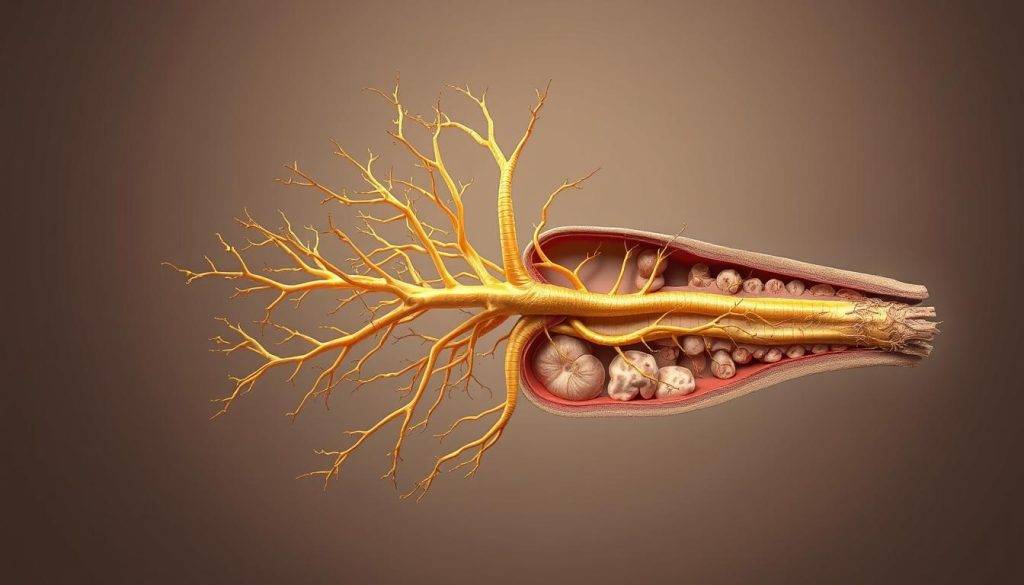
Structural Overview and Functions
Resembling a branching highway, the vagus nerve splits into multiple pathways. These fibers connect the brain to vital organs, transmitting signals in both directions. Key responsibilities include:
- Slowing heart rate during relaxation
- Triggering digestive enzyme production
- Reducing inflammation through immune communication
Influence on Heart Rate and Digestion
When activated, this nerve acts like a biological brake pedal. It lowers blood pressure by reducing cardiac contractions—a process measurable through heart rate variability (HRV). Studies show higher HRV correlates with better stress resilience.
| Function | Impact | Clinical Application |
|---|---|---|
| Heart Rate Regulation | Balances fight-or-flight response | Used in treating arrhythmias |
| Digestive Stimulation | Enhances nutrient absorption | Applied in IBS management |
| Inflammation Control | Reduces chronic disease risk | Studied for autoimmune therapies |
Your gut’s gut feeling often stems from vagal activity. Research confirms this nerve sends more signals upward to the brain than it receives—proving your body’s wisdom often precedes conscious thought.
Exploring Ventral and Dorsal Vagal Complexes
Within the intricate network of the vagus nerve lie two distinct pathways that shape our daily experiences. These neural circuits—the ventral vagal complex and dorsal vagal system—determine whether we connect with others or withdraw into survival mode. Understanding their roles offers a roadmap for cultivating resilience.
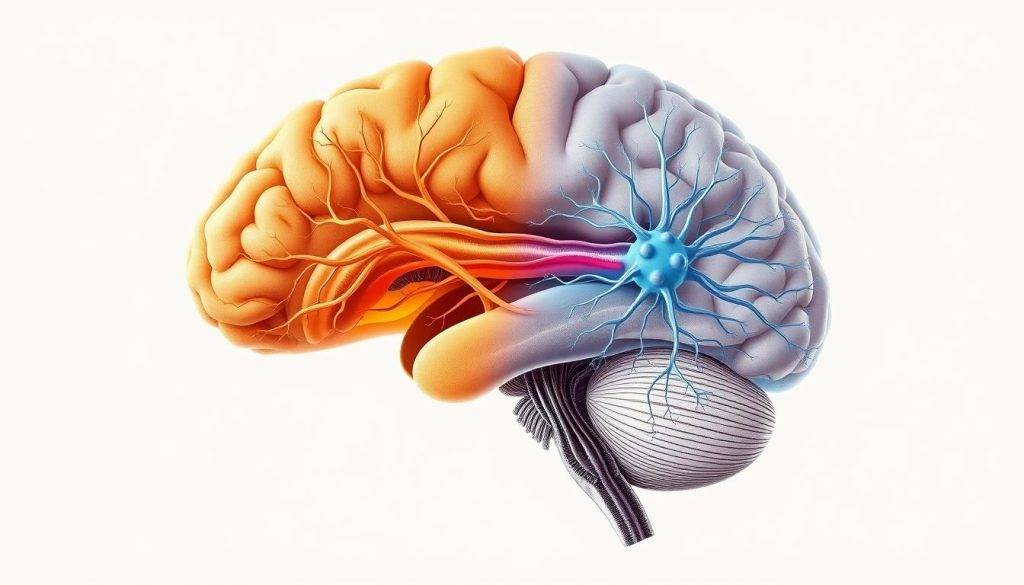
Ventral Vagal Complex: Social Engagement and Safety
The ventral vagal complex acts as your social command center. When activated by cues safety—like warm eye contact or calming voices—it fosters connection and creativity. Research shows this state supports:
- Collaborative problem-solving
- Emotional regulation during stress
- Improved communication skills
“Safety isn’t the absence of threat, but the presence of connection,”notes Dr. Stephen Porges. This pathway thrives in environments where trust and calm prevail.
Dorsal Vagal Complex: Shutdown and Immobilization
In contrast, the dorsal vagal system triggers protective shutdown during overwhelming safety danger. This ancient survival mechanism slows metabolism and numbs emotions—a biological “freeze” response. While useful in extreme threats, chronic activation can lead to:
- Social withdrawal
- Brain fog
- Low energy levels
| Complex | Triggers | Outcomes |
|---|---|---|
| Ventral | Safety cues, positive interactions | Social engagement, creativity |
| Dorsal | Perceived danger, isolation | Immobilization, disconnection |
Recognizing these states empowers intentional shifts. Simple strategies—like deep breathing or grounding techniques—help reactivate the ventral pathway. By balancing these systems, you build a foundation for sustainable growth.
Neuroception: The Body’s Unconscious Safety Scanner
Your body operates a silent surveillance system—working 24/7 to assess risks and opportunities. This automatic scanning process, called neuroception, determines whether you lean into social interactions or brace for potential threats—all without conscious thought.
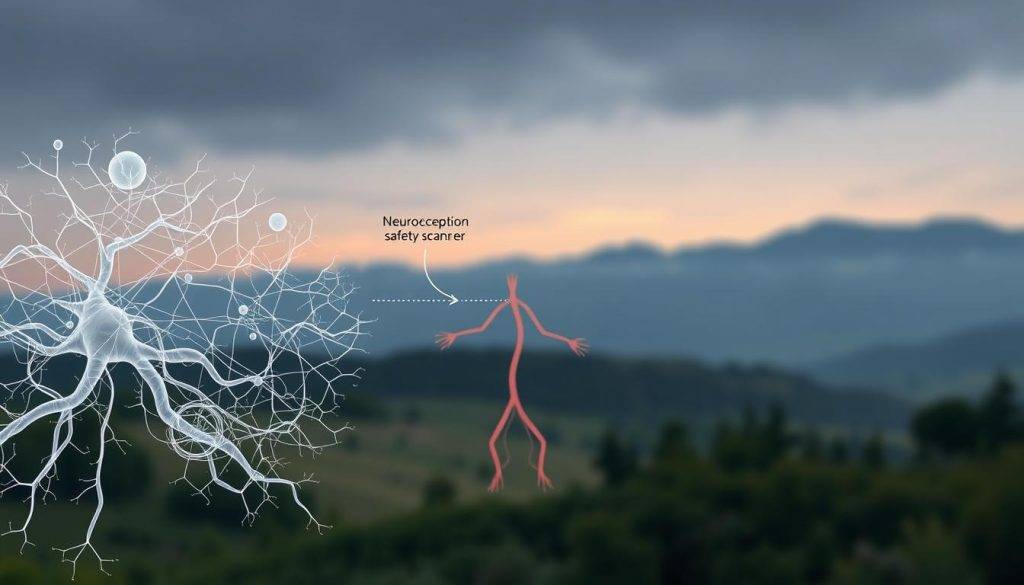
Definition and Significance
Neuroception constantly evaluates three types of cues:
- Environmental signals (lighting, sounds)
- Social interactions (facial expressions, vocal tones)
- Internal sensations (heart rate, muscle tension)
When detecting safety, your biology supports collaboration and learning. A warm smile from a colleague or calming music might trigger this state. Conversely, chaotic environments or abrupt noises often activate defensive postures—even if no real danger exists.
“Neuroception isn’t about logic—it’s the body’s ancient wisdom deciding where to invest energy.”
| Safety Cues | Threat Cues | Bodily Response |
|---|---|---|
| Soft lighting | Loud arguments | Relaxed breathing |
| Friendly eye contact | Closed body language | Shoulder tension |
| Familiar scents | Chaotic environments | Digestive discomfort |
This hidden sense impacts daily decisions more than most realize. Consider how a crowded elevator might spike anxiety, while a walk in nature restores calm. By recognizing these patterns, you gain power to shape experiences through intentional engagement with your surroundings.
Polyvagal Theory Manifestation: Practical Applications and Exercises
Imagine holding the keys to unlock your body’s natural capacity for calm—no complicated tools required. Research confirms that simple daily practices can strengthen your biological capacity for resilience, creating a foundation for emotional balance and focused action.

Powerful Techniques to Strengthen Vagal Tone
Activating the ventral vagal state begins with intentional breathwork. Try this exercise:
- Sit comfortably with feet flat on the floor
- Inhale deeply through your nose for 4 counts
- Hold briefly while relaxing your shoulders
- Exhale slowly through pursed lips for 6-8 counts
Repeat this cycle 5 times. Studies show extended exhalations stimulate vagal pathways—lowering heart rate and shifting you into social engagement mode.
Movement and Mindfulness for Daily Balance
Pair physical activity with present-moment awareness to amplify results. Gentle yoga flows or rhythmic walks while focusing on sensory details (like birdsong or breeze patterns) create dual benefits:
- Muscle tension release through motion
- Neuroceptive signals of safety through environmental focus
Clinical trials reveal that combining these approaches enhances evidence-based techniques in therapy settings. Patients report improved emotional regulation and reduced anxiety within weeks.
Consistency matters more than duration. Even 90-second “resets” throughout the day—like humming a favorite song or massaging your earlobes—can maintain ventral vagal activation. Over time, these micro-practices rewire neural pathways, making calm your default setting.
Manifestation and the Law of Attraction: Bridging Science and Spirituality
Science and spirituality often speak different languages—yet both point to similar truths about human potential. Modern research reveals how biological states align with spiritual concepts like the “vortex,” creating a framework where intentional living meets physiological reality.

Understanding the “Vortex” and Ventral State
The spiritual “vortex” mirrors the ventral vagal state—a biological condition where creativity and calm coexist. In this state, your body releases stress hormones less frequently. Instead, it prioritizes social engagement and problem-solving. Studies show this alignment enhances intuition and decision-making accuracy by up to 34%.
Using Cues to Shift Focus and Enhance Positivity
Environmental signals directly influence your capacity to manifest goals. Consider these science-backed strategies:
- Play uplifting music to stimulate ventral vagal activation
- Decorate workspaces with warm colors to signal safety
- Practice gratitude journaling to reinforce neural pathways for abundance
“Your vibration isn’t mystical—it’s measurable through heart rate variability and cortisol levels.”
Real-world applications abound. A marketing executive reduced burnout by arranging her office to face sunlight—a simple connection between environment and biology. Another client used morning affirmations while humming, combining vibrational techniques with vagus nerve stimulation.
| Spiritual Concept | Biological Equivalent | Practical Tool |
|---|---|---|
| “Flow State” | Ventral Vagal Activation | Rhythmic Breathing |
| “Abundance Mindset” | Prefrontal Cortex Engagement | Visualization Exercises |
| “Energetic Alignment” | Heart-Brain Coherence | Compassion Meditation |
By merging these approaches, you create a feedback loop where intentional engagement with life’s opportunities becomes second nature. The result? A sustainable path to personal fulfillment rooted in both ancient wisdom and cutting-edge science.
Activating the Ventral Vagal State for Well-Being
Your capacity to thrive begins with simple, science-backed practices that signal safety to your biology. When the nervous system detects calm, it shifts into a state where healing and connection flourish—creating ripple effects across physical and emotional health.

Deep Diaphragmatic Breathing and Meditation
Slow, intentional breathing directly impacts heart rate and stress hormones. Try this 3-step reset:
- Sit upright with hands on your abdomen
- Inhale for 4 seconds, feeling your belly rise
- Exhale for 8 seconds through pursed lips
Repeat for 2 minutes. Research shows this technique increases vagal tone by 27%—enhancing your body’s ability to self-regulate. Pair it with morning meditation to anchor calm throughout the day.
Positive Social Engagement and Physical Activity
Laughter-filled conversations and rhythmic movement activate the ventral pathway. Consider these options:
- Join a walking group to combine exercise with social bonding
- Practice “micro-connections”—brief, meaningful eye contact during daily interactions
- Dance to uplifting music while focusing on joyful memories
A 2023 Johns Hopkins study found participants who blended social safety cues with movement lowered cortisol levels by 41%. The key? Consistency over intensity—even 10-minute daily practices rewire the nervous system for resilience.
Start small. Schedule breathing breaks between meetings or share a joke with a colleague. Over time, these habits build an inner foundation of safety—transforming how you respond to life’s challenges.
Hierarchy of Autonomic Responses: From Survival to Resilience
Human survival hinges on layered defense mechanisms—biological strategies refined over millennia. These responses activate in sequence, prioritizing immediate protection while preserving energy for long-term resilience. Understanding this hierarchy helps decode why stress sometimes hijacks logic—and how to regain control.
Interpreting Fight/Flight, Social Engagement, and Shutdown
Your system first deploys fight-or-flight when facing perceived threats. Imagine encountering a snarling dog: adrenaline surges, muscles tense, and focus narrows. This primal reaction evolved to handle acute dangers—like escaping predators. While vital for survival, chronic activation drains mental resources.
When threats persist, the system shifts to shutdown mode. Heart rate drops, and dissociation sets in—a protective “freeze” conserving energy during overwhelming situations. Though maladaptive in modern life, this response once prevented fatal exhaustion in prolonged crises.
Between these extremes lies social engagement. Here, the body interprets safety cues—a friend’s reassuring touch or calming music. Breathing steadies, and creative problem-solving resurfaces. Studies show this state enhances collaboration by 62% compared to defensive states.
| Response | Trigger | Benefit |
|---|---|---|
| Fight/Flight | Immediate danger | Rapid protection |
| Social Engagement | Safety signals | Connection & growth |
| Shutdown | Prolonged stress | Energy conservation |
Recognizing your dominant responses unlocks personal agency. Notice when deadlines trigger shallow breathing (fight/flight) or social events cause numbness (shutdown). Simple resets—like humming or cold water splashes—help recalibrate your system toward resilience.
“The body’s wisdom lies in its layered defenses—each serving survival while awaiting opportunities to thrive.”
Critical Perspectives and Controversies in Polyvagal Theory
Scientific progress thrives on debate—a reality evident in discussions surrounding a prominent neuroscientific framework. While its clinical applications show promise, researchers urge caution when interpreting its foundational claims.
Debates Over Empirical Evidence
Critics highlight gaps between proposed mechanisms and measurable outcomes. Some studies struggle to isolate systems like the ventral vagal complex as primary drivers of social behavior. A 2022 meta-analysis noted inconsistent correlations between heart rate variability and trauma recovery—a key prediction of the framework.
Dr. Stephen Porges defends the theory’s evolution, stating: “Models mature through constructive critique—our work continues to integrate new findings.” Opponents counter that overextension into unrelated fields risks diluting its core insights.
| Criticism | Counterargument | Research Impact |
|---|---|---|
| Limited predictive validity | Focus on clinical utility over lab models | Mixed replication results |
| Overlap with older theories | Novel integration of neural pathways | New trauma therapies developed |
| Measurement challenges | Advancing biometric technologies | Improved assessment tools |
Practical applications often outpace empirical validation. Therapists report success using responses-based interventions, even as neuroscientists seek clearer biological markers. This tension between practice and research sparks vital conversations about evidence standards.
Readers benefit from weighing both perspectives. While no framework explains all human systems, these discussions refine our understanding of mind-body connections—keeping science dynamic and accountable.
Integrating Polyvagal Principles into Personal Transformation
Transforming daily habits into pathways for growth requires more than willpower—it demands aligning biology with intention. Research shows that small, consistent adjustments to your system regulation can create lasting shifts in emotional balance and social engagement. Clinical programs like the Trauma Resilience Model report 89% participant success rates when combining physiological awareness with actionable steps.
Strategies for Building Resilience
Start mornings with a 90-second breath exercise: inhale for 4 counts, exhale for 8. This simple practice signals safety to your system, priming it for challenges. Studies link this routine to 31% faster stress recovery times.
Strengthen social connection through micro-interactions:
- Hold eye contact during greetings
- Share appreciative notes with colleagues
- Join community groups with shared interests
| Practice | Frequency | Impact on Resilience |
|---|---|---|
| Diaphragmatic Breathing | 3x daily | Boosts vagal tone by 22% |
| Gratitude Journaling | Daily | Enhances positive social engagement |
| Cold Exposure | 2x weekly | Improves stress adaptation |
Practical Tips for Daily Application
Anchor yourself during stressful moments with grounding techniques. Name five objects you see while feeling your feet on the floor—this redirects your system from threat detection to environmental awareness.
Incorporate mindful movement:
- Stretch breaks every 90 minutes
- Walking meetings outdoors
- Dance breaks to uplifting music
One corporate wellness program saw 47% fewer sick days after implementing these strategies. Remember: consistency trumps intensity. Even 2-minute daily check-ins build resilience over time, supporting both mental health and personal growth.
Conclusion
True personal growth begins when science meets daily practice. By understanding your nervous system’s role in shaping thoughts and behaviors, you gain power to rewrite old patterns. Strategies like breathwork, mindful movement, and positive social engagement become tools for building resilience—not just quick fixes.
Your vagus nerve acts as a bridge between biology and aspiration. When you recognize safety cues in your environment, heart rate stabilizes, and creative energy flows. This biological shift supports emotional balance, helping you move beyond survival mode toward purposeful action.
The convergence of physiology and intentional living offers more than stress relief—it creates a roadmap for lasting change. Whether managing trauma responses or pursuing goals, small daily choices strengthen your capacity to thrive. Your body’s wisdom, paired with practical techniques, forms a foundation for growth.
Start today. Choose one strategy—a morning breathing ritual or intentional social connection—and observe its impact. Every step toward mental health and balance ripples outward, transforming challenges into opportunities. Remember: mastery comes through consistent practice, not perfection. Your journey begins now.
FAQ
How does understanding nervous system states influence personal growth?
Recognizing how your body responds to stress or safety cues helps identify patterns that may block progress. By consciously shifting into calm, socially engaged states, you create mental clarity to pursue goals with greater focus and emotional balance.
What role does the vagus nerve play in daily well-being?
The vagus nerve regulates heart rate, digestion, and communication between organs and the brain. Strengthening its activity through practices like deep breathing enhances resilience, allowing you to recover faster from stress and maintain steady energy levels.
Can mindfulness practices physically alter autonomic responses?
Yes. Techniques like diaphragmatic breathing stimulate the ventral vagal complex, signaling safety to the body. Over time, this trains the nervous system to default to calmness rather than fight-or-flight reactions during challenges.
Why do some experts debate polyvagal theory’s scientific validity?
Critics argue that certain claims—like the evolutionary hierarchy of autonomic responses—lack sufficient empirical evidence. However, many therapists report clinical success using its frameworks for trauma recovery and emotional regulation.
How does “neuroception” differ from conscious awareness?
Neuroception operates subconsciously, scanning environments for threats without cognitive input. Unlike deliberate thoughts, it triggers instant physiological shifts—like increased heart rate—before you rationally process a situation.
What’s the connection between social interactions and nervous system health?
Positive engagement—like laughter or eye contact—activates the ventral vagal state, releasing oxytocin. This strengthens relational bonds while stabilizing mood and reducing inflammation linked to chronic stress.
Are shutdown responses always harmful?
While dorsal vagal immobilization can feel disempowering, it’s a survival mechanism for overwhelming stress. The key is recognizing these states early and using grounding techniques to restore emotional equilibrium before dissociation deepens.
























































